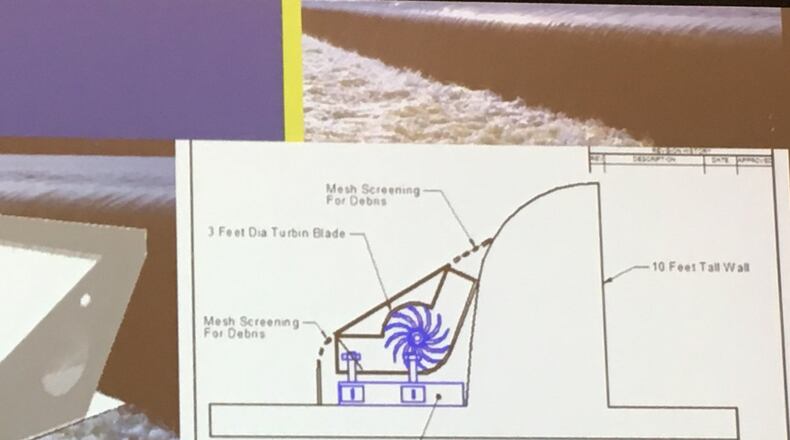The device is to be installed on the downriver side of the dam, and its angle would make Hamilton’s existing “south dam” safer by reducing the churning of river caused by the steep dropping of water as it passes over the dam, which causes a boiling effect that can trap and drown wayward boaters. The dam still would not be safe, but would be less dangerous, Kling said.
“What we have found was this device and these conditions have stunning market potential,” he said. “Each individual site that we build out can produce $1.4 million of revenue per year, has a pay-back on the investment of less than eight years, and has a 25-year operating life.”
The Department of Energy “recently commissioned studies that revealed that there are 70,000 unpowered low-head dams in the United States, and 3 percent of these alone can provide enough power for 10 million homes,” he said. “At the same time, kWRiver Hydroelectric was developing a technology unlike another that requires no modification to the dam, makes the dam safer, produces significant amounts of power continuously, is considered environmentally benign, and is actually unseen beneath the water.”
Dam owners — often cities, or organizations like the Miami Conservancy District in Hamilton’s case — would receive money from the electric sales, while utilities are required to purchase such renewable electricity, Kling said. The devices can be sold, can be owned by the kWRiver, or licensed, he said.
Kurt Rinehart, chief engineer for the conservancy district, said he’s looking forward to seeing actual plans: “We’re waiting until they get more details that we can actually review, and see how it would affect us, or not affect us. Until we see those more details, it’s hard to say how we think it would work.”
That includes an evaluation of how much more safe it could be, Rinehart said. “It’s promising, if the details work out. We’re just waiting for the details to see how this would look, and how it would work.”
“Overall, the market value of the top 2,000 sites of the 70,000 produces over $2.8 billion in revenue per year,” Kling said in his presentation.
Kling said the device is to be installed during the first quarter of 2018 in Hamilton, with sales happening after that.
Kling said the company has “world-class partners,” including TSS Technologies in West Chester, which is building the product.
Kling said no new nuclear plants are scheduled to be built in the country, with 20 percent of those that exist are scheduled to be retired within a decade. And 135 coal-fired power plants have been closed in two years: “That’s the equivalent of the entire state(s) of Colorado and Kentucky combined,” he said.
“There’s been a lot of wind and solar built recently, but even at its best, they have limited capability to supply the energy needs of the United States,” he added. And nearly every large hydroelectric location in the country has been built out, he said.
“Undoubtedly, our technology will have a large impact in the United States,” Kling said. “But we also believe it will be game-changing for humanitarian efforts worldwide. We’re inspired by a phone call that we received several months ago from a Nigerian official who told us this technology would absolutely save lives in his country. When could he get a device?”
The man told Kling “how desperately they need it, and said they would actually build a dam just to build our device,” by providing electricity to clean water for drinking there. “It’s one of the things that’s really motivating us.”
About the Author
